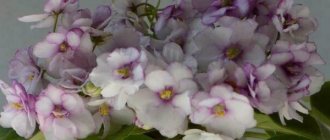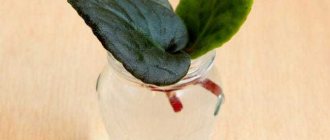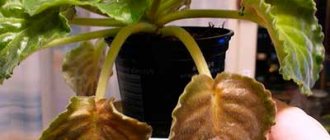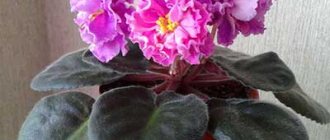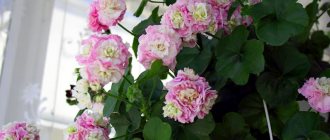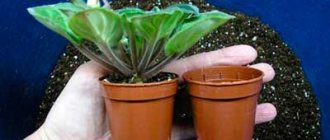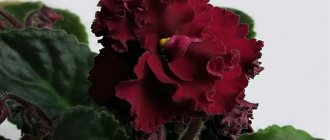Indoor violets are evergreen herbaceous plants with a short stem and leaves on long petioles, collected in a rosette. Saintpaulias are attractive most of the year - with proper care they bloom for 8 or more months a year.
It is with their beautiful flowering that violets have won the hearts of flower growers around the world and now it is difficult to imagine a person who has not seen them at least once in their life.
Violet - the queen of window sills
There are a large number of varieties of violets, which differ from each other in the shape of the flower and leaves. This variety allows you to choose the most suitable variety that will fit perfectly into the interior of the room. But experienced flower growers know that the Maria violet is suitable for everyone.
All gardeners dream of growing violets. This plant is unpretentious, and after a short time it will delight you with long, abundant flowering.
How to care?
Proper watering is very important for “Maria”. Experts recommend watering a houseplant no more than 2 times a week. Two methods of watering are suitable: top and bottom. The first is characterized by filling the violet pot with water “to the brim”, but the leaves are not properly moistened. The bottom method involves filling the pot tray with water.
The liquid for irrigation should be warm. It is not recommended to water violets with ice water. Air humidity in the room is not lower than 50%. You can periodically carefully spray the plant with a spray bottle. During the flowering period, violets need fertilizing with mineral fertilizers (at least 2 times a week).
History of the violet
Violet is an annual or perennial plant. The flower belongs to the Gesneriaceae family. In nature, this flower prefers to grow in the mountainous regions of Africa. This plant is widespread throughout the globe. The minimum requirements for growing conditions are what the indoor violet “Maria” is valued for. The main thing is to create optimal conditions for growth.
They began to grow violets as a houseplant only in the 20th century. During this time, breeders have created many species that delight the eye with their appearance.
But T. Dadoyan gave flower lovers an unforgettable variety of violet “Maria”. The flower is characterized by large, densely double corollas. This variety can truly be called a highlight. The breeders tried to combine all the best in it: a corrugated frill along the edge of the petals, a fantasy pattern of amazing shape. The flower itself resembles a small rose. Maria violet is a luxurious variety with a bright green rosette and attractive pink flowers.
Forum of flower growers Frau Flora
About growing indoor and garden plants; discussion of species, varieties, diseases, pests.
Maria (T. Dadoyan)
Moderator: Floriana
Maria (T. Dadoyan)
Post by Elena M. » 02 Dec 2013, 23:57
Saintpaulia Maria. Breeder T. Dadoyan.
While at the exhibition I saw a copy of the Saintpaulia variety Maria. The owner of the plant is Lyudmila Lysenko. She told me that this is exactly the kind of Mary she should be. The photo shows the second generation of the variety. It was received from an outlet that Tatyana Lvovna Dadoyan personally approved and named Maria. The second generation fully conveyed the varietal characteristics of the source material. After asking Luda’s permission, I decided to show this copy on the forum. Many will now have the opportunity to distinguish the real Maria from other “pseudo Marias” that have bred as a result of various sports from the Fairy and are illegally called Maria.
Re: Maria (T. Dadoyan)
Post by Din-don » 04 Dec 2013, 09:29
Re: Maria (T. Dadoyan)
Post by Yalo » Dec 20, 2013 07:47 pm
Description of the variety
All flower growers know that you cannot stop at one variety of violets. After all, you immediately want to buy a few more beautiful, fluffy and bright plants. Therefore, before purchasing, it is advisable to read the description of the “Maria” violet. This is a fixed sport from the “fairy” variety.
This variety is characterized by densely double flowers, which remain in the form of “heads of cabbage” for a long time in bloom. The petals are white, with a pink tint. Along the edge there is a raspberry-colored border with sputtering and a thick green ruffle. The flowers are large, voluminous, up to 6 cm in diameter. Green ruffle appears in 2-3 blooms. The brightness of the color is affected by the ambient temperature.
The leaves are standard: wavy, rich green. The rosette has curly, wavy leaves that “spin” it. The rosette is loose, the petioles are long. An interesting fact is that when growing a variety on a shelf, the leaves rise up. But if the pot is on the windowsill, all the leaves fall behind the pot. This growth feature directly depends on lighting.
The variety is not early ripening and grows slowly. The Ave Maria violet loves light. Experts recommend bringing several plants to flower at once, because sports often occur. But flower growers claim that all flowering options are beautiful.
The variety is characterized by a long flowering period. The inflorescences do not fade for a long time. Peduncles easily hold large, full heads of cabbage. This variety is unpretentious, produces many children, and grows quickly.
Many people think that the Hail Mary violet is a very sporty one. “Maria” when it blooms, one plant can have 2 peduncles that differ from each other. The main color in the flowers of this variety should be light.
Characteristic
Note that calling this plant a violet is not entirely correct from a terminological point of view. The variety is Saintpaulia, which flower growers call “Uzambara violet”. Therefore, shortening this phrase, we will allow ourselves to designate the amazing indoor plant “Maria” as a violet.
It was presented to lovers of indoor plants by Tatyana Dadoyan. For several years, the woman breeder created flowers for herself, and then showed her amazing “creations” to other people. Dadoyan devoted about 5 years to her hobby and presented more than 10 varieties of her violets to the public. They are distinguished by their amazing shape and stunning shades of inflorescences. The female breeder continues to work on the discovery of new species of Uzambara violets.
It is worth taking a closer look at the description of the “Maria” variety. This is a luxurious indoor plant with delicate original flowers and a rosette of rich green shade. It is necessary to note the following characteristic features:
- the “Maria” variety is famous for its large, double flowers, which bloom for a long time and resemble small roses or “stars”;
- light petals with a pinkish tint (the edges are bright crimson) and a thick green “ruffle”;
- inflorescence size – 4–6 cm;
- the brightness of colors directly depends on the conditions of detention (temperature, availability of light and fresh air);
- wavy green leaves; the rosette is rather loose and has long petioles;
- when growing the variety on shelves, the leaves will rise; a violet, which is “kept” in a flowerpot on the window, will lower the foliage down - this feature completely depends on the presence of light;
- the variety cannot be classified as early ripening; "Maria" grows quite slowly;
- This violet is unpretentious and produces a lot of “babies”.
Another amazing variety of indoor violets is called “LE Maria Mirabella”. Its creator is breeder Elena Lebetskaya.
This Saintpaulia is distinguished by incredible bright pink double flowers - “stars” with a speckled border (corrugated). The inflorescences are characterized by gradual opening, and the spots on the tips of the petals darken day by day.
Plant propagation methods
All gardeners want to grow their own violet on their windowsill. This is quite easy to do. Violets can be grown in several ways:
- cuttings;
- stepsoning;
- propagation by seeds;
- propagation by peduncles.
Violet lovers recommend propagating the plant at home by leaf cuttings or pinching.
Violet cuttings
This method is most often used at home. In this case, rooting occurs almost 100%. But when growing “Virgin Mary” violets, you should remember that this variety is highly athletic. Therefore, no one can guarantee that a flower grown from a leaf will have the same flowering characteristics as the mother plant.
- Carefully cut a strong leaf from a healthy mother plant at an angle.
- The leaves are rooted both in water and in soil or a peat tablet.
- The cut leaf should be rooted immediately.
- You can create greenhouse conditions for it using a glass.
- After some time, babies will appear on the cuttings. At this stage, you should carefully remove the leaf.
- Under favorable conditions, the violet will bloom in 1 year.
Growing
As we have already said, this plant is quite unpretentious, but you should pay attention to the following tips before planting it:
- the pot should be of medium size, since the plant will dynamically grow its root system, so a container that is too small will lead to the death of the violet;
- It is better to place “Maria” on the western or “eastern side; the lighting should completely “envelop” the plant, so do not forget to turn it periodically;
- It’s a good idea to purchase artificial lighting (fluorescent lamps are suitable);
- the optimal air temperature for violets is up to 22 degrees above zero;
- this variety does not welcome constant drafts and direct sunlight;
- use a special soil for Saintpaulia or a mixture (it contains leaf, coniferous and peat soils with the addition of baking powder).
Reproduction by stepson
This method is excellent for propagating the Maria violet variety. After all, it guarantees that the new plant will inherit all the maternal qualities.
- We choose a strong mother plant.
- The stepson must have more than 3 leaves.
- Carefully cut off the stepson with a sharp tool. You can use an awl or a sharp knife. At the same time, be careful not to injure the main rosette of the violet.
- For rooting, you can use a peat tablet or soil purchased in advance from the store.
- In order for the stepson to quickly take root, greenhouse conditions should be created within 1 month.
Watering
Proper watering of violets is the basis for long-term and high-quality development of the plant. It should be moderate; experts recommend watering the plant twice a week. Both upper and lower methods are used.
The top method of watering involves filling the pot with water over the edge, making sure that the water does not get on the surface of the leaves. This is not a very effective method, since the soil is moistened unevenly.
Bottom watering involves placing pots with plants in a tray of water, to which fertilizer is often added.
You need to water with settled and heated water.
Maria
Location
Story
Reminder for a newbie!
Uzambara (Uzumbar) violet is a plant of the Gesneriaceae family, growing in the natural environment of tropical and subtropical regions of Asia, Africa, Eastern Australia, South America and the Indian Ocean islands.
Saintpaulia is a plant named after the Saint-Paul father and son, who brought a plant unknown to Europeans from the Uzambara district (modern Tanzania) in the 19th century, presented for the first time at the international flower exhibition in Ghent in 1893.
Indoor violet has been one of the most popular plants in indoor floriculture since 1927. By 1949, more than 100 varieties had been bred, and today their number exceeds several thousand.
Rooting
- possibly in water, in substrate, moss.
Priming
- purchased soil or a mixture of leaf, coniferous, turf and peat soil in a ratio of 3:1:2:1 with the addition of raising agents (perlite, vermiculite, river sand, crushed sphagnum moss.
Lighting - it is best to place flower pots on western or eastern windows. To ensure that the plant is evenly illuminated from all sides, the pots are periodically rotated. In winter, when daylight hours decrease, you can use artificial lighting - fluorescent lamps.
Caring is a real art and serious painstaking work at the same time, including watering, fertilizing, and creating a favorable humid climate. Water Saintpaulias as the soil dries. The soil must be moistened regularly, but excess moisture should not stagnate in the roots. When watering, you must ensure that water does not get on the leaves. You cannot water the Uzambara violet with cold water. Fertilizing is done with complex mineral fertilizer once every two weeks. Saintpaulia reacts negatively to a lack of nitrogen in the soil. Optimal air humidity is approximately 50%, temperature is 20-22 ° C, without sudden fluctuations and drafts. The leaves of the plant should not touch the window glass. Removal of faded flowers and damaged leaves is carried out regularly.
Reproduction - planting a leaf cutting, part of a leaf, or a daughter rosette. The most popular method is rooting leaf cuttings. The formation of roots and the development of children lasts 4-8 weeks.
Pests are one of the gardener's problems. There are many different types of pests and it is very difficult to classify them. Among Saintpaulia pests, several groups can be distinguished: mites (spider mites, flat mites, transparent mites, etc.), insects (aphids, thrips, springtails, poduras, scale insects, whiteflies, scale insects, etc.), worms (nematodes).
Diseases - distinguish between infectious (gray rot, powdery mildew) and non-infectious diseases (rotting of the stem and root, wilting of the lower leaves, yellowing, leaf spotting, incomplete opening and premature drying, falling of flowers) of plants. The causative agents of infectious diseases are bacteria, fungi, and viruses. To prevent infectious diseases, you should strictly observe the regimes of watering, temperature, humidity, and lighting. Non-communicable diseases usually arise due to poor agricultural practices. They may appear in one instance and not spread to others.

